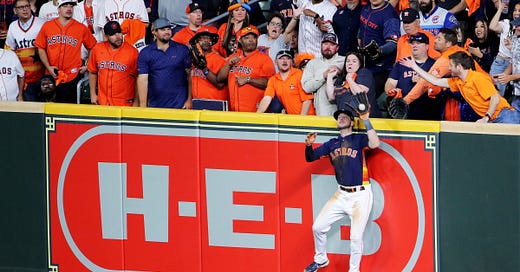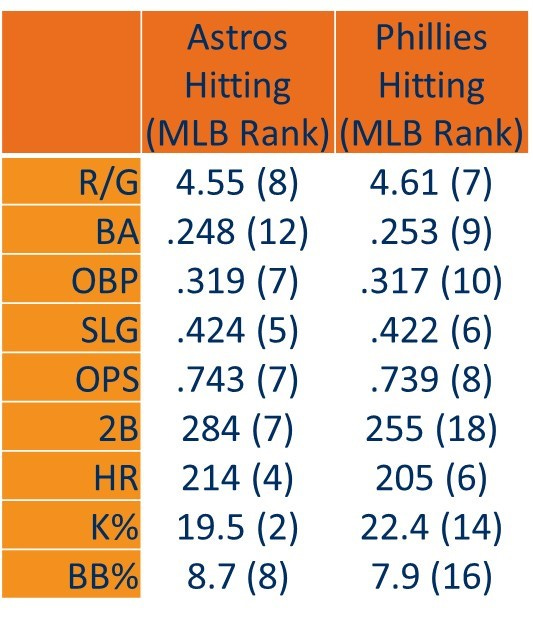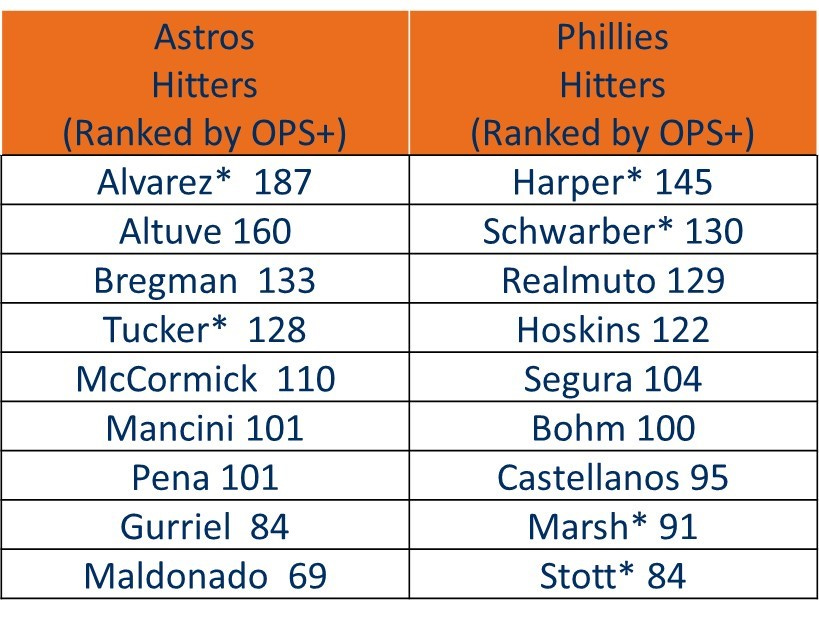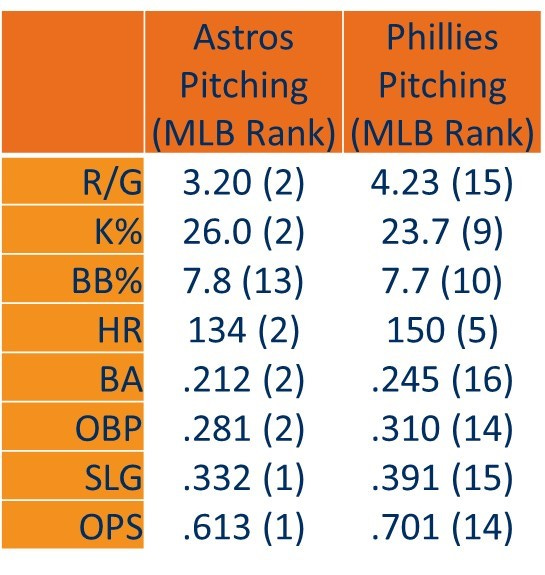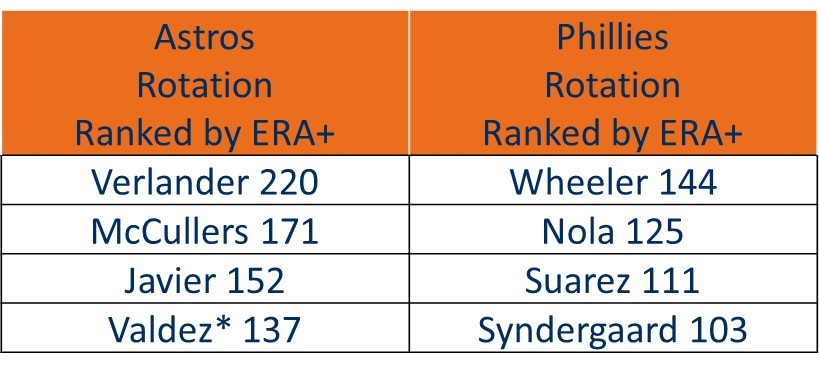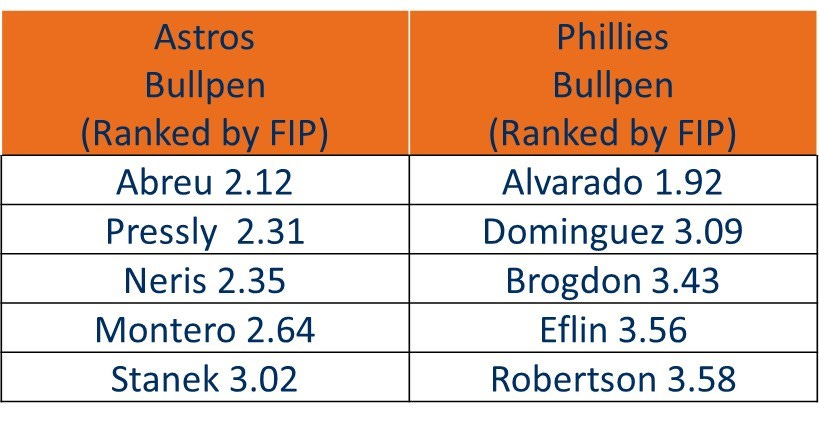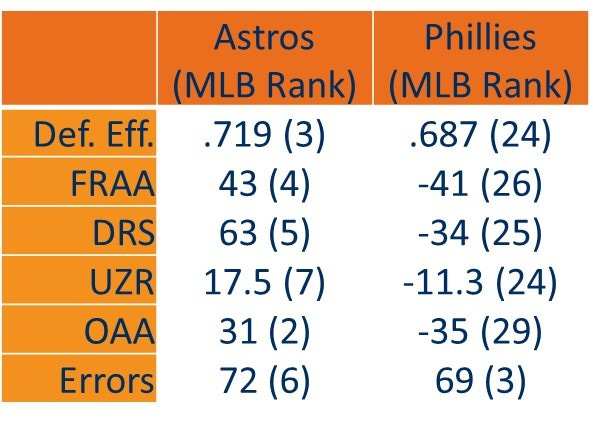The Astros are Deeper and Match Up Well With the Phillies; But that May Not Matter; My World Series Preview
The Offenses are Similar, But the Astros Have an Advantage on the Mound and a Giant Advantage with the Gloves. But in a Short Series, Those Advantages May Not Show Up.
With both Champion Series clinched on Sunday and Fox’s programming schedule dictating that the games cannot start until Friday, the wait has seemed interminable.
But today it is here: the World Series begins today.
And more importantly, for the fourth time in the last six years, our Astros are in it. Having dispatched the Yankees in 4 games, the Astros have advanced to face the Phillies and to seek revenge for the team’s loss in the 1980 National League Championship Series. #WinItForTerryPuhl.
As always, I will preview the series by looking at each team’s key offensive and defensive numbers (including fielding) across the season and discuss the lineups, rotations, and bullpens, ranking each by a broad metric of run creation (OPS+) or prevention (ERA+ for starters; FIP for relievers).
Such a method allows me to focus on the broader quality of the two teams. Then I discuss “what to watch for” in the series, which talks about the areas of the series where one team can exploit another’s weakness or where the strengths of the two teams will create a big inflection point in the series.
The focus on regular season numbers leads me to a clear (and I think pretty obvious) conclusion: the Astros are a better baseball team. In particular, the Astros have a big advantage on the mound and a gigantic advantage with their gloves. The offenses are pretty close to equals—the two were separated by only 10 runs scored over the course of the season.
So it is advantage Astros. But in a short series, advantages are always modest. Sometimes teams have clear advantages over other teams that show up in a short series—the Mariners pitching staff gives up a lot of home runs and the Astros hit a lot; and we saw a big Astros advantage in homers in the ALDS. And sometimes these advantages do not show up in a short series—the Yankees are great at drawing walks and the Astros give up too many free passes, but the Yankees did not draw walks at a high rate in the ALCS.
The Astros have clear advantages in home run prevention, making contact, and catching the ball. The question of this series is will they show up on the field.
These two teams played three games in the regular season, but only one was conducted as a true competition—the first game of that series.1 Kyle Schwarber hit a pair of solo home runs, Bryson Stott added another and Aaron Nola struck out nine in 6.2 innings on the mound. The Astros had all the same advantages in home run prevention and making contact in the game as they do walking into this series, but those advantages did not matter because the Philles overcame them.
And they overcame them because players like Schwarber and Nola are good. The Phillies have a number of good players, but the Astros have more. But in a short series, a team’s depth is less meaningful. Instead, more of the innings and plate appearances will be focused on each team’s best players.
If the Phillies play better, then can overcome their disadvantages. But the advantages clearly lay with the Astros.
The Hitting
The offenses are very similar. You can see that very easily in the numbers in the chart below. The two teams are only 2 points away from each other in On Base Percentage and Slugging Percentage. As a result, the two teams are right next to each other in MLB rank in OPS—the Astros 7th and the Phillies 8th—and in Runs/Game—where the Phillies are 7th and the Astros are 8th.
The similarities extend to the number of home runs hit by both offenses—they are only 9 home runs apart over the course of the season.
But their is a clear difference in the plate approaches used by each team. The Phillies are right in the middle of MLB in taking walks and in striking out. The Astros are a top third team in drawing walks, and are an absolute top tier team when it comes to making contact.—they are second best in the majors in avoiding strikeouts.
The Phillies lack of walks are due in large part to their willingness to chase pitches out of the strike zone. They swung at 34.3% of those pitches this season, which is the fifth highest rate in the majors. Their contact rate on those pitches is high (64.0%; 13th best in MLB) and their swinging strike rate overall is mid-tier (11.2%; 14th in MLB). But making contact on pitches out of the strike zone leads to weaker contact and more outs.
The Lineups
The similarity of the two teams offensively is also present looking at the hitters in each lineup. Both team have 4 players at a star level that anchor each team’s lineup. They each have another set of hitters who are just above or below league average. It’s more similarity.
But there are a couple of important differences. The Phillies have an advantage at the bottom of the chart. Their worst hitter (Bryson Stott) had the same OPS+ as the Astros 2nd worst hitter (Yuli Gurriel), which makes Martin Maldonado the worst hitter in the series, but a large margin.
But just as Maldonado is the worst hitter, Yordan Alvarez is the best margin, and by a large margin. And Jose Altuve is the best hitter, at least based on OPS+ for the 2022 season. The Phillies may have a higher floor to the offense than the Astros, but the Astros have a higher ceiling.
The Pitching
The similarities among the bats do not hold up on the mound. Instead, we see a clear advantage on the mound for the Astros, as they allowed a run less per game than the Phillies over the course of the regular season. The Astros led the major leagues in slugging and OPS allowed, and were second best in on base percentage allowed, bating average against, and strikeout rate.
The Phillies are decidedly a mid-tier team in most pitching categories. Their best numbers are in the three true outcomes—they are 5th best at preventing home runs, 9th best at striking out the opponent, and 10th best in walk rate. But once the ball is put into play, the Phillies pitching numbers are right around the middle of the league.
The Astros biggest weakness as a pitching staff is their propensity to give up walks. This was a big worry for us Astro fans in both of the previous playoff series. The Mariners and Yankees both have some of the highest walk rates in the majors. The Phillies do not, as they are a mid-tier team at drawing walks.
The Rotation
The Phillies are team with two ace level pitchers, one solid third starter, and some league average options for their fourth starter. The Astros feature two ace level pitchers of their own. But they have an advantage in the third and fourth spots in the rotation, where they have two other starters better any option the Phillies have for those spots.
The Phillies tend to be a stars and scrubs team and that is most evident in their pitching staff. They are anchored by Zack Wheeler and Aaron Nola, both of whom are All-Star level pitchers.
Wheeler will face off with Framber Valdez in Game 2, and you can see that he had a better ERA+ over the course the season. Nola, who is the Phillies #2 starter, will take on Verlander in Game 1. Verlander has pitched better this season.
These matchups are relatively even, but the Astros have a huge advantage in Games 3 and 4. The Astros will start pitchers at the level of Wheller and Nola, and the Phillies will not. Ranger Suarez is a good pitcher, but he’s not at the level of Lance McCullers or Cristian Javier. And the Phillies have a massive disadvantage in Game 4, whether they go with Syndergaard (or Bailey Falter) or push Nola on short rest.
The Bullpens
The top of the Phillies bullpen matches up with that of the Astros, but the Astros depth is unmatched by their rival.
We have seen the Astros deep bullpen be stars throughout this postseason. The Astros have received broad contributions from a number of pitchers, which has made decision-making easier for Dusty Baker. He has been able to make smooth bullpen decisions, usually bringing in new relievers to start a “clean inning.” As a result, he has used his bullpen in a linear fashion. Ryan Pressly has anchored the bullpen with 4 saves in 5 games pitched.
Phillies manager Rob Thompson has used his best bullpen arms aggressively. Jose Alvarado has pitched in 8 of their 11 postseason games, and Seranthony Dominguez and Zack Eflin has both appeared in 6. He has prioritized those three for the most high leverage situations. He does not assign relievers to specific innings, but instead tries to gain matchup advantages based on what part of the lineup he is facing.
As a result, he has gotten saves from 4 different relievers this postseason.
The Astros have broader depth in their bullpen. Relievers like Bryan Abreu and Ryne Stanek are stronger than Elfin or Dave Robertson. The Phillies will try to maximize the innings they get from their strongest relievers, just like they have so far this postseason.
Fielding
The Astros have a massive advantage in fielding in this series. A massive advantage.
Defensive statistics are notoriously finicky and some favor some teams and players over others. But even with that baked into the numbers, the chart below shows the same story—the Astros have one of the best defenses in the majors, and the Phillies have one of the worst.
The chart looks at a number of advanced defensive metrics, but the Astros advantage is most well shown by the simplest measure on the table—Defensive Efficiency. This stat measures the share of balls hit into play that are turned into out. The Astros turn 3% more balls in play into outs. Over the course of 162 games, that adds up, keeping more runners off the basepaths and reducing run scoring.
Almost all of the Astros defensive advantage comes in the outfield. The Astros defense is led by Gold Glove candidate Kyle Tucker, who is credited with 14 runs saved on defense. The Phillies right fielder is Nick Castellanos, who is credited with -8 defensive runs saved. And Castellanos is the better defending corner outfielder for the Phillies; Kyle Schwarber recorded -14 defensive runs saved in left field.


The Phillies did address their defense over the course of the season. They released Didi Gregorius to let Bryson Stott, a better defender, take over at shortstop. And they addressed their outfield defense by trading for Brandon Marsh to play Kelly Leak between Schwarber and Castellanos in the outfield. But even with that, the Phillies have a weak defense. This is the biggest edge on the field.
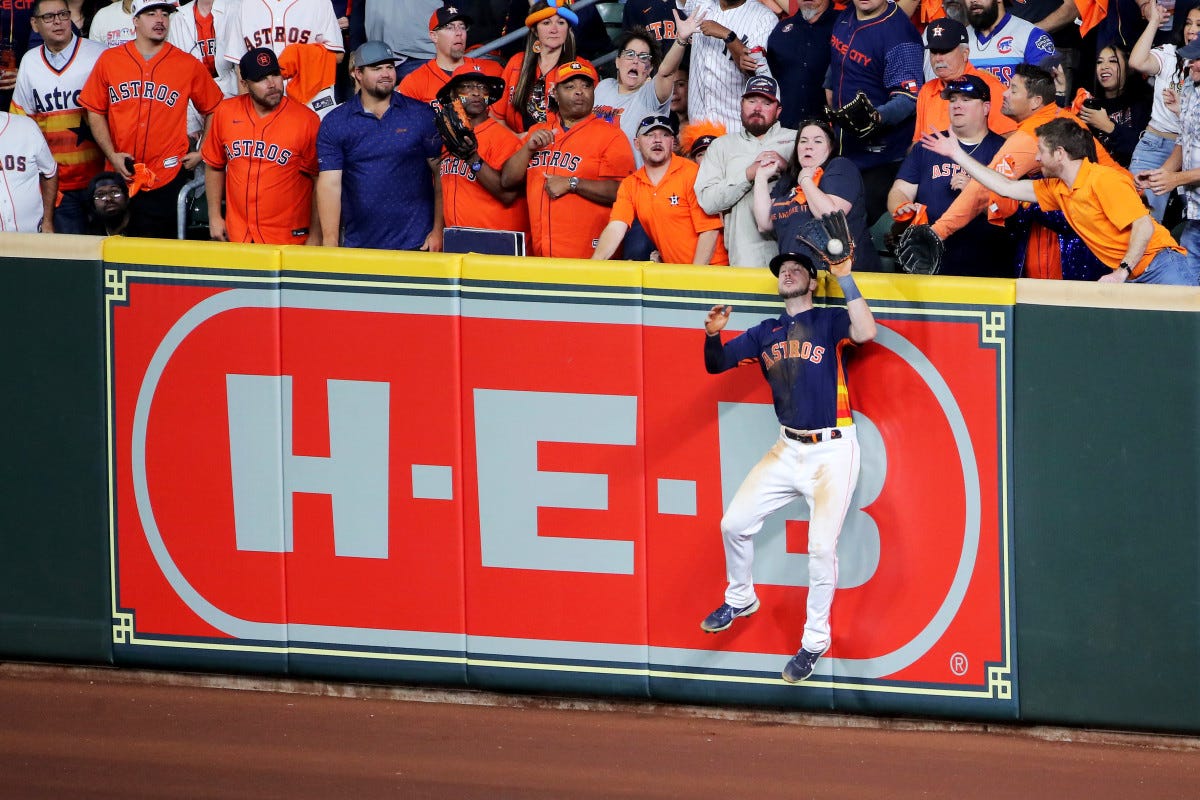
Things to Watch
Can the Phillies catch the ball? The Astros are a high contact team at the plate and strike out very little. The Phillies are a good, but not great team at striking batters out. Put those together and a higher number of ball will be put into play and will test the Phillies weak defense. The combination bodes well for the Astros and poorly for the Phillies. Of course, in a short series, this advantages can be muted.
How many innings do the Phillies get from their top arms? So far in the playoffs, the top five pitchers (Wheeler, Nola, Suarez, Alvarado, & Dominguez) for the Phillies have thrown 63.1 of their 97 postseason innings; that’s 69.4%. They have little trust in their pitchers beyond those five and will want to maximize their innings this series. Forcing the Phillies to pitch lots of innings from their mediocre pitchers would tip the scales toward the Astros. The Phillies will consider having Wheeler and Nola come out of the bullpen on days between their starts.
Who wins the games where Nola and Wheeler pitch? The Phillies have two ace pitchers that lead their rotation, and then will be at a decided disadvantage on the mound in the other three games of the series. It is critical for the Phillies to win the majority of the games where the starting pitching matchup is close to a coin flip, because their odds of winning the other three games are much lower.
Keeping the Phillies from homering. The Phillies have a lot of big power, led by Kyle Schwarber who led the National League with 45 homers this season. The Astros were second in the majors in preventing home runs. I have made this a “thing to watch” in every series because in modern baseball, who homers more matters a ton to who wins. It’s hard to string rallies together with multiple base hits, and that is especially true against the Astros pitching and defense—which held opposing hitters to a .212 batting average on the season. I again cite Joe Sheehan’s aphorism—ball go far, team go far. Keep the Phillies from hitting it far and their team won’t go far this series.
Conclusion
Reviewing the numbers and strengths of the team leads me to two conclusions.
First, the Astros are deeper in high quality baseball players than the Phillies. The Phillies can match the Astros for star power at the top of their lineup, their rotation, and their bullpen. But the Astros have a deeper pool of really good players, especially on the mound.
Second, the areas where the Phillies have strengths play into where the Astros have strengths. And the Phillies weaknesses tend to be in areas where the Astros are weakest.
For example, the Phillies strength on offense is hitting homers. But the Astros are strong at preventing homers. And the Phillies are a mid-tier team in walk rate, which will make it harder for them to take advantage of the weakness of the Astros pitching staff—issuing walks.
In short, it is hard to see where the Phillies have clear advantages in this series. They have a pair of ace starting pitchers, but so do the Astros. They hit a lot of home runs, but so do the Astros.
But it is much clearer to see where the Astros have advantages. Their defense is a significant help in run prevention, taking baserunners away and making the opponent more reliant on hitting for power, which the Astros pitching staff does not allow.
And the depth of the Astros pitching staff will give the Astros a clear advantage at the start of the games that Suarez and Falter start and in the middle innings of any game where the Phillies starter cannot go deep.
And those advantages mean that the Astros are but a modest favorite to win four out of the next seven games. The Fangraphs odds gives the Astros a 58.2% chance of winning the series. Five Thirty Eight is more optimistic for the Orange and Blue, giving our boys a 68% chance of winning the series.
Those odds are good, but of course not great. They leave plenty of scenarios for the Phillies to spring the upset. In fact at those odds, maybe it is not even an upset.
Baseball is of course a game in which breaks and luck play a vital role. It is part of what makes the sport dramatic and fun…if you are not cheering for the favorite in a series.
But in our case as Astros fans, it will be a nerve-wracking next four to seven games. Our boys are better. Let’s hope that matters.
Their win that night clinched a playoff spot for the Phillies, and they celebrated as they should. The game after a postseason celebration is known colloquially in baseball as a hangover game, and the Phillies played like it; the Astros won 10-0. The third game of the series was the last day of the regular season—with huge last day of school vibes.
Bailey Falter started Game 4 of the NLDS, but the Astros are strong against left handed pitching, so I’m guess in the Phillies will opt for Syndergaard, a righty, in Game 4. Regardless, that pitcher will not be in the game for long, even if he pitches well.

